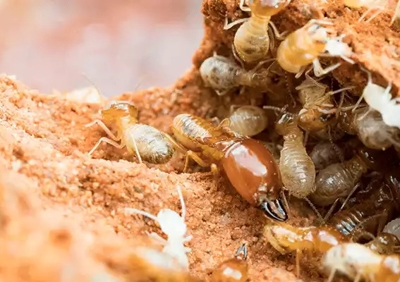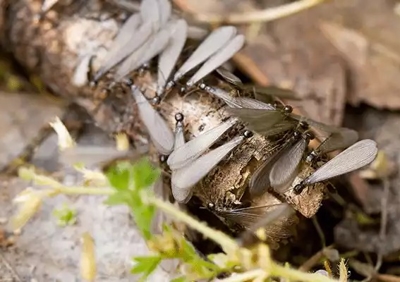
Learn About Termites
Frequently Asked Questions
-
What are termites?Termites are wood-destroying insects that live together in large colonies and work as a group to grow their ever-expanding colonies. Termites are responsible for causing billions of dollars’ worth of damages to properties all across the country each year. In our part of Florida, there are two species of termites found living and causing damages to homes, businesses, and wooden structure — the subterranean termite and the drywood termite.
-
What are the differences between subterranean termites and drywood termites?
The biggest difference between subterraneans and drywoods is where they nest. Subterranean termites have an underground nest, they move back and forth from their food source to their underground nest either through underground tunnels or through mud tubes that they create. In contrast, drywood termites nest inside the wood that they have they infested and are feeding on. Also, subterranean termites require soil to wood contact in order to invade a structure, while drywood termites do not require soil to wood contact to invade a wooden structure. Also, subterranean termite colonies are typically much larger in size than drywood termite colonies.
-
How do I tell the difference between termite swarmers and winged ants?
Being able to tell the difference between winged termite swarmers and winged ants is important so that the correct treatment can be sought and performed. Differences between the two species of winged reproductives include:
- Winged ants have obviously bent antennae while the winged termite has straight antennae.
- Winged ants have three distinctive body segments, while the winged termite’s body is more uniform in shape and lacks 3 distinctive body segments.
- Both species have two pairs of wings; however, both pairs of the termite’s wings are the same length, while the ants back wings are significantly shorter in length than their front wings.
- The ant’s wings are tinted brown in color, in contrast, the termite’s wings are whitish or translucent in color.
-
Are termites dangerous?
Termites are not a threat to human health. They do not bite, sting or transmit disease.
Termites are a major threat to structures. Left unchecked, they have the ability to inflict significant damages to the structures of homes, outbuildings, and commercial structures.
-
Why do I have a termite problem?Both subterranean and drywood termites infest seasoned wood. If your structure has water damaged wood or other materials that attract these pests, then it is likely you will develop a termite infestation. In fact, we always say In Florida, there are two types of homes- ones that have termites and ones that are going to get them.
-
How do I get rid of termites?
The only way to get rid of a termite infestation and prevent a re-infestation is to seek help from a trained and experienced professional. At Keller’s Pest Control, we are experts in termite control for Bradenton and all of Manatee County as well as Sarasota, Pinellas, Hillsborough, and Charlotte counties. As licensed pest control professionals, we have the necessary expertise and tools needed to eliminate termites, no matter what the species or how severe the infestation.
Our termite control services start with a thorough inspection to determine what type of termites are present and how severe the infestation is. We’ll also identify conducive conditions and note the termite damage we find. Based on our assessment, we’ll develop a plan of action and implement. For more details about our services specific to subterranean and drywood termites, please visit our termite control page or simply give us a call!

-
 Subterranean Termites
Subterranean TermitesSubterranean termites are divided into workers, soldiers or reproductive (castes), which caste that they are in will determine their appearance.
Termite workers are cream-colored insects with soft bodies and no wings. They group up to ½ of an inch. They are tasked with providing food for their colony. You may never know you have termite workers infesting the wood in your home because they consume it from the inside, leaving the outer layer intact. Property owners may discover these pests in the soil around their structures or inside if they are remodeling or making repairs.
Termite soldiers are very similar in appearance to workers except that they have brownish colored heads and very large mandibles that they use to defend their colony with.
The reproductive members of the colony are the largest in size and can grow up to ½ an inch in length. Also known as termite swarmers, they are dark in color and are winged insects. Property owners are more likely to see this caste than others as they swarm (inside or outside) in order to mate and establish new colonies.
-
 Drywood TermitesDrywood termites also divide themselves into three separate castes and look very similar in appearance to the subterranean termite. However, unlike the subterranean termites the workers, soldiers, and reproductives are not as easily distinguished between each other.
Drywood TermitesDrywood termites also divide themselves into three separate castes and look very similar in appearance to the subterranean termite. However, unlike the subterranean termites the workers, soldiers, and reproductives are not as easily distinguished between each other.

Pests Beware. We Care!
Trust Keller's Pest Control For Reliable Service With Integrity
-
No Obligation Estimates
-
Family-Owned & Operated
-
29+ Years in Business
-
Knowledgeable Technicians
-
Customer Top-Rated
-
No Contracts


-
"A+ Communication"I've been using Keller's for over three years now and they've been great. I've had some bug problems and they have been very responsive at fixing them even if it meant showing up out of cycle to handle. Communication is key and they get an A+.- Jeff I.
-
"Exceptional Company"Keller's Pest Control is exceptional in every way! Their team is knowledgeable, professional, and genuinely dedicated to ensuring a pest-free home. From quickly addressing serious issues to providing regular, reliable maintenance, they’ve exceeded.- Aleks S.
-
"Outlined Treatment Plan"The technician was great and clearly explained what issues we were having in our home. They outlined the treatment plan to address those issues and the time frame. Very friendly and we look forward to a great relationship as their happy customer.- Kevin A.
-
"10+ Year Customer"I’ve used Keller’s for pest control at my house for more than 10 years. They have always provided excellent, speedy, and complete service. It's pleasure to do business with them.- Bob W.
-
"They Explained Everything"Keller's was very quick to respond to my call and came to the house at my convenience. They did such a great job at explaining things and I went with the quarterly service plan. Very reasonable pricing and gave us piece of mind.- Ron Q.
-
"Longtime Customer"We have been working with Keller’s for a long time and could not be happier with their service and expertise. They are responsive and honest. We appreciate the technicians and the office team. Thank you, Keller’s Pest Control!- Christine S.
-
"Bed Bugs Gone"Keller’s Pest Control is by far the best service we’ve ever had! Patrick Keller is professional, thorough & amiable. The bugs have been gone ever since they first serviced us! We will continue our service can’t recommend them enough.- Sara M.
-
"4+ Year Customer"We have used them for over 4 years. Our technician is very knowledgeable and professional. We are gone from the property sometimes as long 4 months and never have any pest issues. We highly recommend Keller’s Pest Control.- Bill B.
-
"Knowledgable & Efficient"The technician was so knowledgeable about my bed bug issue. They came in with a heat machine and eliminated the bug quickly and efficiently. I was able to get my rental back in action the next day! Great company.- Christopher W.

Go With the Team You Trust.
See Our Proud Affiliations, Certifications & Awards

-
 Pest Library
Pest Library -
 Read Our Blog
Read Our Blog -
 Save on Service
Save on Service









